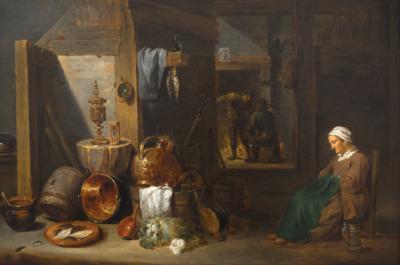David Teniers II
(Antwerp 1610–1690 Brussels)
An elderly woman in a barn,
signed lower left: D TENIERS f,
oil on panel, the reverse marked with the brand of the Antwerp panel makers’ guild, 42 x 62.5 cm, framed
Provenance:
Collection of Ludwig Zatzka;
art market, London;
Gallery Caretto, Turin, 1991;
Private collection, Milan;
art market, Italy;
where acquired by the present owner
We are grateful to Fred Meijer for confirming the attribution on the basis of a photograph.
The present peasant scene is a typical example of Teniers’ genre paintings for which he is best known. The virtuosity of his technical skill is particularly demonstrated in the left foreground of the painting. The details of the vessels and luminosity of his paint strokes bring the rich textures of this still life arrangement to full prominence. An elderly woman seated to the right is also partially bathed in light and appears to be napping. The richness of the foreground is in stark contrast to the more muted, neutral tones of her attire and surroundings. In the background, we see two revellers in animated discussion in front of a hearth, and they point to Teniers’ intimate observation of contemporary life and human expression.
David Teniers II was one of the most prolific seventeenth century genre painters. He was born in Antwerp in 1610 and studied under his father David Teniers the Elder, before becoming a master in the Guild of Saint Luke in Antwerp. When the painter Adriaen Brouwer moved from Haarlem to Antwerp and introduced Teniers to peasant scenes, it marked a turning point in the career of the artist. By 1649 he was working for the King of Spain, as well as for the Prince William of Orange and by 1651 he worked for the governor of the Netherlands, the Archduke Leopold Wilhelm, as a court painter. Despite his fame as a genre painter, he continued to paint landscapes and still life, religious and allegorical subjects throughout his career, demonstrating his versatility as an artist. His work was also influenced by his father-in-law Jan Brueghel the Elder and the fluid, painterly technique of Peter Paul Rubens. He died in Brussels in 1690.
Specialist: Damian Brenninkmeyer
 Damian Brenninkmeyer
Damian Brenninkmeyer
+43 1 515 60 403
damian.brenninkmeyer@dorotheum.at
24.04.2024 - 18:00
- Estimate:
-
EUR 60,000.- to EUR 80,000.-
Follow Remove
David Teniers II
(Antwerp 1610–1690 Brussels)
An elderly woman in a barn,
signed lower left: D TENIERS f,
oil on panel, the reverse marked with the brand of the Antwerp panel makers’ guild, 42 x 62.5 cm, framed
Provenance:
Collection of Ludwig Zatzka;
art market, London;
Gallery Caretto, Turin, 1991;
Private collection, Milan;
art market, Italy;
where acquired by the present owner
We are grateful to Fred Meijer for confirming the attribution on the basis of a photograph.
The present peasant scene is a typical example of Teniers’ genre paintings for which he is best known. The virtuosity of his technical skill is particularly demonstrated in the left foreground of the painting. The details of the vessels and luminosity of his paint strokes bring the rich textures of this still life arrangement to full prominence. An elderly woman seated to the right is also partially bathed in light and appears to be napping. The richness of the foreground is in stark contrast to the more muted, neutral tones of her attire and surroundings. In the background, we see two revellers in animated discussion in front of a hearth, and they point to Teniers’ intimate observation of contemporary life and human expression.
David Teniers II was one of the most prolific seventeenth century genre painters. He was born in Antwerp in 1610 and studied under his father David Teniers the Elder, before becoming a master in the Guild of Saint Luke in Antwerp. When the painter Adriaen Brouwer moved from Haarlem to Antwerp and introduced Teniers to peasant scenes, it marked a turning point in the career of the artist. By 1649 he was working for the King of Spain, as well as for the Prince William of Orange and by 1651 he worked for the governor of the Netherlands, the Archduke Leopold Wilhelm, as a court painter. Despite his fame as a genre painter, he continued to paint landscapes and still life, religious and allegorical subjects throughout his career, demonstrating his versatility as an artist. His work was also influenced by his father-in-law Jan Brueghel the Elder and the fluid, painterly technique of Peter Paul Rubens. He died in Brussels in 1690.
Specialist: Damian Brenninkmeyer
 Damian Brenninkmeyer
Damian Brenninkmeyer
+43 1 515 60 403
damian.brenninkmeyer@dorotheum.at
|
Buyers hotline
Mon.-Fri.: 10.00am - 5.00pm
old.masters@dorotheum.at +43 1 515 60 403 |
| Auction: | Old Master Paintings |
| Auction type: | Saleroom auction with Live Bidding |
| Date: | 24.04.2024 - 18:00 |
| Location: | Vienna | Palais Dorotheum |
| Exhibition: | 13.04. - 24.04.2024 |

